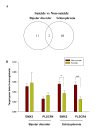Suicide candidate genes associated with bipolar disorder and schizophrenia: an exploratory gene expression profiling analysis of post-mortem prefrontal cortex
- PMID: 17997842
- PMCID: PMC2211497
- DOI: 10.1186/1471-2164-8-413
Suicide candidate genes associated with bipolar disorder and schizophrenia: an exploratory gene expression profiling analysis of post-mortem prefrontal cortex
Abstract
Background: Suicide is an important and potentially preventable consequence of serious mental disorders of unknown etiology. Gene expression profiling technology provides an unbiased approach to identifying candidate genes for mental disorders. Microarray studies with post-mortem prefrontal cortex (Brodmann's Area 46/10) tissue require larger sample sizes. This study poses the question: to what extent are differentially expressed genes for suicide a diagnostic specific set of genes (bipolar disorder vs. schizophrenia) vs. a shared common pathway?
Results: In a reanalysis of a large set of Affymetrix Human Genome U133A microarray data, gene expression levels were compared between suicide completers vs. non-suicide groups within a diagnostic group, namely Bipolar disorder (N = 45; 22 suicide completers; 23 non-suicide) or Schizophrenia (N = 45; 10 suicide completers ; 35 non-suicide). Among bipolar samples, 13 genes were found and among schizophrenia samples, 70 genes were found as differentially expressed. Two genes, PLSCR4 (phospholipid scramblase 4) and EMX2 (empty spiracles homolog 2 (Drosophila)) were differentially expressed in suicide groups of both diagnostic groups by microarray analysis. By qRT-PCR, PLSCR4 and EMX2 were significantly down-regulated in the schizophrenia suicide completers, but could not be confirmed in bipolar disorder.
Conclusion: This molecular level analysis suggests that diagnostic specific genes predominate to shared genes in common among suicide vs. non-suicide groups. These differentially expressed, candidate genes are neural correlates of suicide, not necessarily causal. While suicide is a complex endpoint with many pathways, these candidate genes provide entry points for future studies of molecular mechanisms and genetic association studies to test causality.
Figures



Similar articles
-
Genome-wide expression analysis detects eight genes with robust alterations specific to bipolar I disorder: relevance to neuronal network perturbation.Hum Mol Genet. 2006 Jun 15;15(12):1949-62. doi: 10.1093/hmg/ddl118. Epub 2006 May 10. Hum Mol Genet. 2006. PMID: 16687443
-
Correlation analysis between genome-wide expression profiles and cytoarchitectural abnormalities in the prefrontal cortex of psychiatric disorders.Mol Psychiatry. 2010 Mar;15(3):326-36. doi: 10.1038/mp.2008.99. Epub 2008 Sep 2. Mol Psychiatry. 2010. PMID: 18762803
-
Expression of microRNAs and other small RNAs in prefrontal cortex in schizophrenia, bipolar disorder and depressed subjects.PLoS One. 2014 Jan 27;9(1):e86469. doi: 10.1371/journal.pone.0086469. eCollection 2014. PLoS One. 2014. PMID: 24475125 Free PMC article.
-
Gene expression profiling in schizophrenia and related mental disorders.Neuroscientist. 2006 Aug;12(4):349-61. doi: 10.1177/1073858406287536. Neuroscientist. 2006. PMID: 16840711 Review.
-
Better understanding of mechanisms of schizophrenia and bipolar disorder: from human gene expression profiles to mouse models.Neurobiol Dis. 2012 Jan;45(1):48-56. doi: 10.1016/j.nbd.2011.08.025. Epub 2011 Sep 3. Neurobiol Dis. 2012. PMID: 21914480 Free PMC article. Review.
Cited by
-
MicroRNA-382 expression is elevated in the olfactory neuroepithelium of schizophrenia patients.Neurobiol Dis. 2013 Jul;55:1-10. doi: 10.1016/j.nbd.2013.03.011. Epub 2013 Mar 29. Neurobiol Dis. 2013. PMID: 23542694 Free PMC article.
-
Construction and analysis of the protein-protein interaction networks for schizophrenia, bipolar disorder, and major depression.BMC Bioinformatics. 2011;12 Suppl 13(Suppl 13):S20. doi: 10.1186/1471-2105-12-S13-S20. Epub 2011 Nov 30. BMC Bioinformatics. 2011. PMID: 22373040 Free PMC article.
-
RNA-sequencing of the brain transcriptome implicates dysregulation of neuroplasticity, circadian rhythms and GTPase binding in bipolar disorder.Mol Psychiatry. 2014 Nov;19(11):1179-85. doi: 10.1038/mp.2013.170. Epub 2014 Jan 7. Mol Psychiatry. 2014. PMID: 24393808 Free PMC article.
-
Discovery and validation of blood biomarkers for suicidality.Mol Psychiatry. 2013 Dec;18(12):1249-64. doi: 10.1038/mp.2013.95. Epub 2013 Aug 20. Mol Psychiatry. 2013. PMID: 23958961 Free PMC article.
-
Application of microarray outlier detection methodology to psychiatric research.BMC Psychiatry. 2008 Apr 23;8:29. doi: 10.1186/1471-244X-8-29. BMC Psychiatry. 2008. PMID: 18433482 Free PMC article.
References
-
- Hawton K, Sutton L, Haw C, Sinclair J, Harriss L. Suicide and attempted suicide in bipolar disorder: a systematic review of risk factors. J Clin Psychiatry. 2005;66:693–704. - PubMed
Publication types
MeSH terms
Grants and funding
LinkOut - more resources
Full Text Sources
Other Literature Sources
Medical

